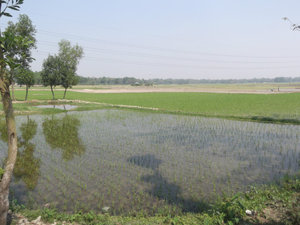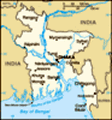Advertisement
Published: February 27th 2013

 The Countryside of Bangladesh
The Countryside of Bangladesh
All along the way we passed rice paddies and people replanting them. Some were seedling paddies where people were picking each plant to be replanted like this one. Rice is such hard work.To check out another part of Bangladesh, I went bird watching with a couple colleagues on the northern border near India, in a wetlands area named Tanguar Haor. Before I moved to Bangladesh I had heard that it was the best place for bird watching in Asia. The whole country is a river delta. The Bradt guide says "If you're supremely adventurous or a keen birdwatcher (perhaps both), Sunamganj is where you'll want to head." It also mentions that it takes four days on a boat to do the round trip from Sunamganj to Tanguar Haor, staying on the boat at night and waking up surrounded by birds in the wetlands.
A haor is a large depression in the earth, which creates a wetlands area. Water trickles in from nearby rivers and rains fill the depressions. Considering how flat and saturated Bangladesh is, some water is probably forced up from underground. The shallow water and abundant fish and plant life creates an ideal habitat for birds. Many Asian birds stop by during their winter migrations. There are several haors in northern Bangladesh, but Tanguar is reputed to be the most pristine.
It was a long day traveling up from

 Farming the Dry Season
Farming the Dry Season
When rain isn't falling every day, especially when it hasn't rained in months, people have to rely on irrigation. All farming is done the old-fashioned way, by hand or with water buffalo pulling the plow. Dhaka on Thursday, (see map notes) but we made it. The next morning we got up ready for action. Like all good (and nerdy) birdwatchers, we were armed with cameras, tripods, binoculars and a bird book specifically about South East Asia. We had hats and sunscreen and were ready for a day out on a boat, quietly watching birds. After a later-than-anticipated breakfast, we rode in a laguna for over an hour to the boat, which turned out to be bright red. They had obviously made a new awning for us, to shelter us from the sun. It was flashy red and yellow fabric, complete with bunting around the edges and bright red chairs. It was stunning. No bird in its right mind would go within a mile of it. (They don’t have hummingbirds here). But we got on, and politely greeted the four other guys onboard, who turned out to be the boat owner, boat driver, haor guide and a friend of the owner. Add them to our group of five: guide, manager of the place in Sunamganj and three foreigners. There were too many people to actually keep quiet.
Motoring up the river, on the way to

 Laguna
Laguna
Across the river from Sunamganj there were only rickshaws, motorcycles and lagunas. It's a CNG vehicle, bigger, but just as bumpy and noisy.the haor we spotted lots of Brahminy kites and drongos, which can also be found in Dhaka. We saw hooded crows and sparrows, domesticated ducks and geese, starlings and mynah birds. Once in the haor I got to see lots of birds that I had never seen before. Some of these are probably mis-identified since we couldn’t get very close and only had one book with drawings to work from. On my list are: great and intermediate egrets, Indian pond herons, coots, Oriental Darters, great and little cormorants, Pacific reef-herons, Great-billed herons, juvenile Grey herons, several kinds of gulls and terns, black kites, purple swamp hens, little grebes, fulvous whistling ducks, common potchards, common shelducks and ruddy shelducks, Eurasian wigeons, purple herons, red-crested pochards and Oriental skylarks. My favorites were the purple swamp hens. They were the size and shape of a chicken, but bright purple with red beaks.
The best bird watching was from the Swiss research station, where we got out on foot, away from the bright red boat, chugging engine and ringing cell phones. The larks were singing and the ducks stood still in the shallows. I got a good look at a purple heron, walking

 Living on the River
Living on the River
Many fishermen live on boats like the one in the foreground. The blue boat behind is a school, often sponsored by an NGO or foreign charity. This one is funded by BRAC bank.up close behind some willows, watching it stalk around in the reeds, catching fish and turning in the afternoon light, so the sun caught the red neck feathers and purple wing feathers at different angles. It was beautiful.
The rest of the trip we were the focus of attention. That must be the most frequent comment about Bangladesh: everywhere we went, people crowded around to stare. Even on the boat, since we were accompanied by six local men, I always felt eyes on me. We didn’t see any other foreigners the whole time, including the road trip to and from Dhaka.
I had expected the long trip from Dhaka, but didn’t realize that from where we were staying it was another three hours of laguna and motor boat to the haor. That’s a six hour daily commute. The countryside is beautiful, and if other things had gone better it would have been okay. Unfortunately, we had other problems. The lodging was unexpected and they were obviously unprepared to host tourists. I didn’t feel comfortable there. The political situation blew up on Friday while we were out in the boat and we were rushed back to Dhaka on Saturday,

 Bridges
Bridges
We passed a lot of bridge building projects, replacing the bamboo bridges with sturdy cement ones. Cement is less poetic, but is also less likely to be swept away in monsoon floods.in anticipation of country-wide protests and strikes on Sunday. It was a shame to have the trip cut short, but considering how it was going we probably didn’t miss out on too much.
There were a lot of beautiful places we passed through, and I would like to learn more about Bangladeshi culture and living on rivers and around the wetlands, so I would do it again. If there were to be a next time, I would first talk to the guide about his local knowledge (it’s never a woman) and arrange to go on a boat that we can sleep on, to save us the six hours of transportation each day.
This blog is also available on www.heatherjasper.com
Advertisement
Tot: 0.707s; Tpl: 0.012s; cc: 26; qc: 122; dbt: 0.3875s; 1; m:domysql w:travelblog (10.17.0.13); sld: 1;
; mem: 1.5mb



 The Countryside of Bangladesh
The Countryside of Bangladesh
 Farming the Dry Season
Farming the Dry Season
 Laguna
Laguna
 Living on the River
Living on the River
 Bridges
Bridges





























teresa
non-member comment
Hi! Just wanted to say that I\'ve been keeping up with the posts and everything sounds amazing (except for the snafus on this trip I suppose...). Hope you are happy with your life in Bangladesh :-)